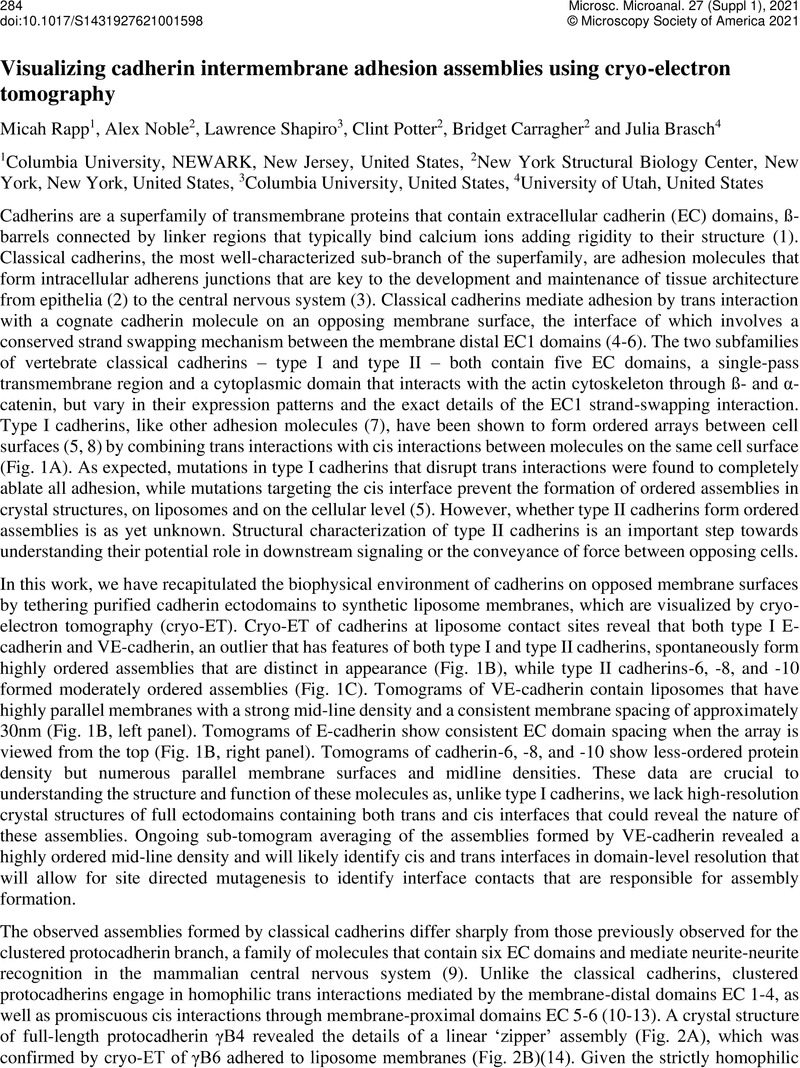No CrossRef data available.
Article contents
Visualizing cadherin intermembrane adhesion assemblies using cryo-electron tomography
Published online by Cambridge University Press: 30 July 2021
Abstract
An abstract is not available for this content so a preview has been provided. As you have access to this content, a full PDF is available via the ‘Save PDF’ action button.

- Type
- 3D Structures: From Macromolecular Assemblies to Whole Cells (3DEM FIG)
- Information
- Copyright
- Copyright © The Author(s), 2021. Published by Cambridge University Press on behalf of the Microscopy Society of America
References
Hulpiau, P., van Roy, F., Molecular evolution of the cadherin superfamily. The International Journal of Biochemistry & Cell Biology 41, 349-369 (2009).CrossRefGoogle ScholarPubMed
Farquhar, M. G., Palade, G. E., Junctional complexes in various epithelia. The Journal of cell biology 17, 375-412 (1963).CrossRefGoogle ScholarPubMed
Hirano, S., Takeichi, M., Cadherins in brain morphogenesis and wiring. Physiological reviews 92, 597-634 (2012).CrossRefGoogle ScholarPubMed
Shapiro, L. et al. , Structural basis of cell-cell adhesion by cadherins. Nature 374, 327-337 (1995).CrossRefGoogle ScholarPubMed
Harrison, O. J. et al. , The extracellular architecture of adherens junctions revealed by crystal structures of type I cadherins. Structure 19, 244-256 (2011).Google ScholarPubMed
Brasch, J. et al. , Homophilic and heterophilic interactions of type II cadherins identify specificity groups underlying cell-adhesive behavior. Cell reports 23, 1840-1852 (2018).CrossRefGoogle ScholarPubMed
Aricescu, A. R., Jones, E. Y., Immunoglobulin superfamily cell adhesion molecules: zippers and signals. Current opinion in cell biology 19, 543-550 (2007).CrossRefGoogle Scholar
Boggon, T. J. et al. , C-cadherin ectodomain structure and implications for cell adhesion mechanisms. Science 296, 1308-1313 (2002).CrossRefGoogle ScholarPubMed
Lefebvre, J. L., Kostadinov, D., Chen, W. V., Maniatis, T., Sanes, J. R., Protocadherins mediate dendritic self-avoidance in the mammalian nervous system. Nature 488, 517-521 (2012).CrossRefGoogle ScholarPubMed
Rubinstein, R. et al. , Molecular logic of neuronal self-recognition through protocadherin domain interactions. Cell 163, 629-642 (2015).CrossRefGoogle ScholarPubMed
Goodman, K. M. et al. , Structural basis of diverse homophilic recognition by clustered α-and β-protocadherins. Neuron 90, 709-723 (2016).Google ScholarPubMed
Goodman, K. M. et al. , γ-Protocadherin structural diversity and functional implications. Elife 5, e20930 (2016).Google ScholarPubMed
Goodman, K. M. et al. , Protocadherin cis-dimer architecture and recognition unit diversity. Proceedings of the National Academy of Sciences 114, E9829-E9837 (2017).CrossRefGoogle ScholarPubMed
Brasch, J. et al. , Visualization of clustered protocadherin neuronal self-recognition complexes. Nature 569, 280-283 (2019).CrossRefGoogle ScholarPubMed


